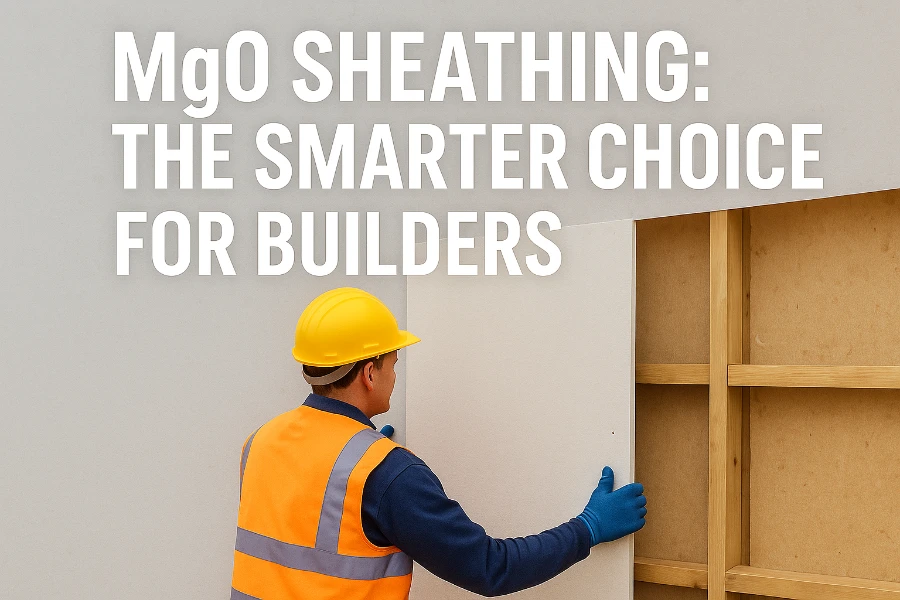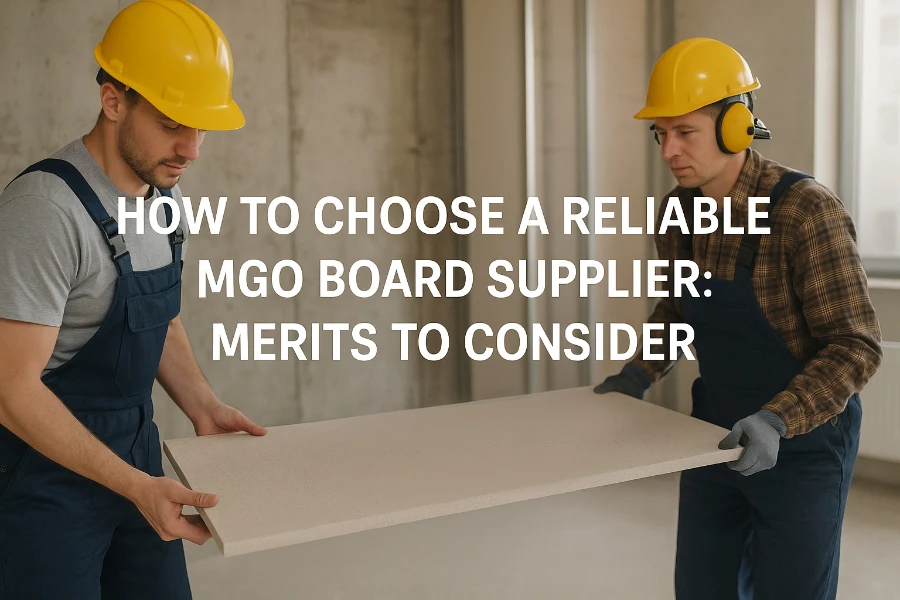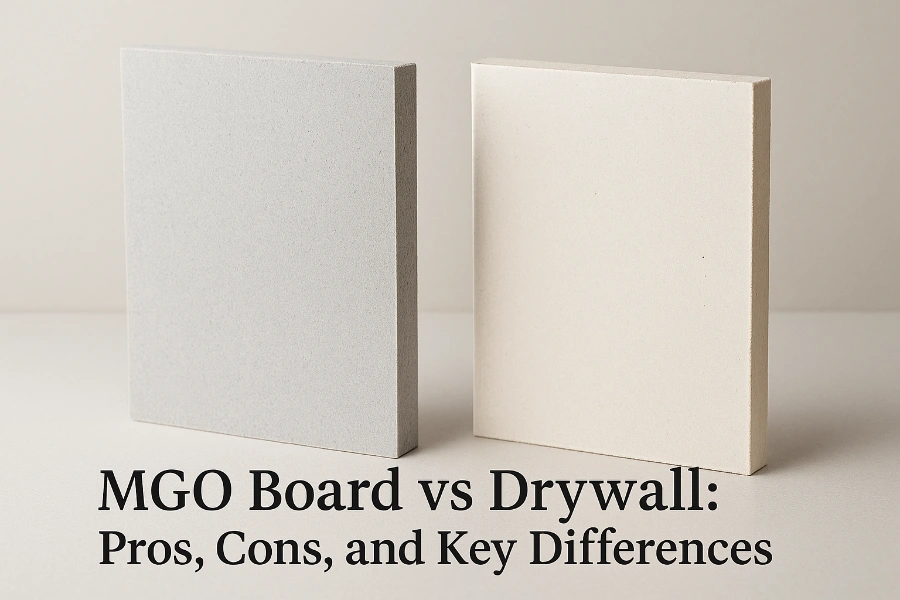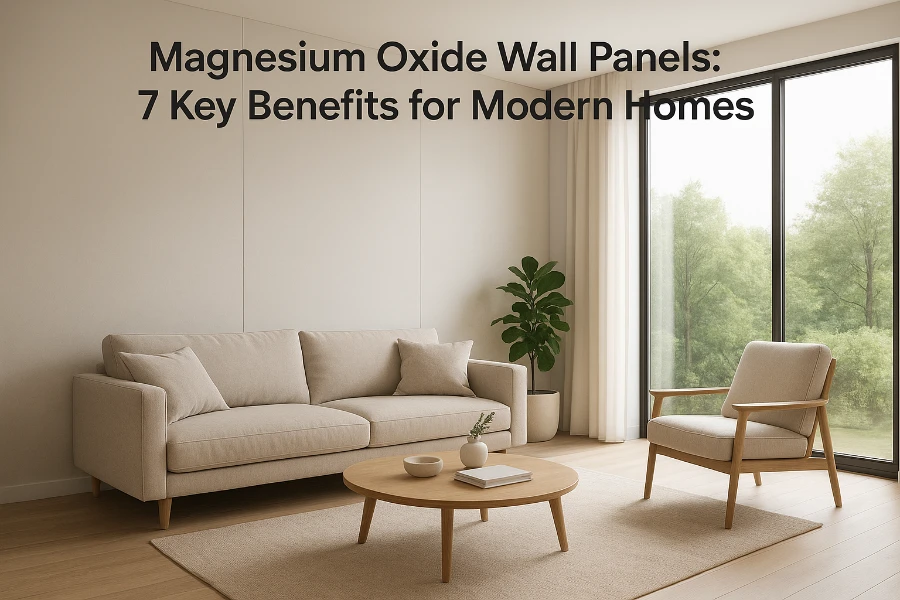Table of Contents
1. Introduction
In today’s construction industry, builders are under constant pressure to select materials that not only deliver strong performance but also meet increasingly strict standards for safety, durability, and sustainability. Traditional sheathing products such as gypsum board, oriented strand board (OSB), and cement board have been widely used for decades, but they often fall short in environments where fire resistance, moisture protection, or long-term durability are critical.
This is where MgO sheathing—short for magnesium oxide sheathing—comes into play. Engineered to withstand fire, water, mold, and impact, magnesium oxide sheathing has quickly become a reliable alternative for builders who want more than just the basics. It offers a forward-looking solution that combines safety and structural integrity with environmental responsibility.
As construction projects increasingly demand compliance with green building standards such as LEED and BREEAM, MgO sheathing stands out as a material that can meet both technical and environmental requirements. This article explores what MgO sheathing is, its benefits, applications, and why it is considered the smarter choice for modern builders.
2. What Is MgO Sheathing?
MgO (magnesium oxide) sheathing is a type of construction board manufactured from magnesium oxide, a naturally occurring mineral known for its excellent fireproofing and strength. The boards are typically reinforced with fibers and other additives to enhance durability, creating a lightweight yet robust material that can replace traditional gypsum or cement-based products.
From a functional perspective, magnesium oxide sheathing is used as an external or internal wall covering, roof underlayment, and substrate for various finishes such as paint, tile, or cladding. It serves the same purpose as other sheathing products—providing structural stability, protecting against the elements, and forming a base for finishing layers—but with significantly improved performance characteristics.
Key differences from conventional options include:
-
Fire Resistance: MgO is non-combustible and can withstand extremely high temperatures, making it an ideal choice for fire-rated assemblies.
-
Moisture & Mold Protection: Unlike gypsum, which absorbs water and loses integrity, magnesium oxide sheathing remains stable in damp or humid conditions.
-
Strength & Versatility: It offers higher impact resistance and dimensional stability compared to OSB or plywood, while being compatible with a wide range of construction systems.
In short, MgO sheathing is not just another building board—it is a high-performance solution designed to meet the modern builder’s need for safety, efficiency, and sustainability.
3. Key Benefits of MgO Sheathing for Builders
3.1 Exceptional Fire Resistance
One of the strongest advantages of MgO sheathing is its non-combustible nature. Classified as an A1 fire-rated material, it can withstand direct exposure to flames and extremely high temperatures without igniting, emitting toxic smoke, or compromising its structure. For builders working on high-rise projects, schools, hospitals, or commercial spaces, this property ensures compliance with stringent fire safety regulations and provides peace of mind for both contractors and building owners. By using magnesium oxide sheathing, fire-rated wall and roof assemblies can be designed with greater confidence and long-term safety.
3.2 Superior Moisture & Mold Resistance
Builders often struggle with materials like gypsum sheathing that absorb water and deteriorate in humid or wet conditions. MgO sheathing, however, is naturally resistant to moisture, preventing warping, swelling, or softening. Even in coastal regions or areas with high rainfall, the board maintains its integrity and performance. Moreover, its resistance to mold and mildew growth reduces maintenance costs and extends the life of the building envelope. For projects such as basements, bathrooms, and exterior walls, magnesium oxide sheathing provides a durable solution that traditional boards cannot match.
3.3 High Structural Strength & Durability
Beyond fire and moisture resistance, MgO sheathing delivers excellent mechanical strength. The boards offer high impact resistance, dimensional stability, and superior load-bearing capacity compared to OSB or plywood. Builders can count on magnesium oxide sheathing for long-term durability, especially in structures that require resilience against heavy use or extreme environmental conditions. Its ability to resist cracking, delamination, and surface damage ensures that projects maintain their quality for decades.
3.4 Environmental Friendliness
Sustainability is no longer optional in modern construction—it is an expectation. MgO sheathing is manufactured with low energy consumption compared to Portland cement-based materials and contains no harmful chemicals such as asbestos, formaldehyde, or silica dust. The board is fully recyclable and contributes positively to green building standards such as LEED by supporting credits related to indoor air quality, recycled content, and environmental performance. For builders engaged in eco-conscious projects, magnesium oxide sheathing is an excellent way to meet both environmental goals and client expectations.
3.5 Ease of Installation
Despite its advanced performance, MgO sheathing is easy to handle and install. Builders can cut, drill, and fasten it using standard woodworking tools, making it highly practical on-site. The board is compatible with a wide range of finishes—including paints, veneers, tiles, and siding—providing flexibility for different design requirements. Its lightweight nature compared to cement board also reduces labor strain and speeds up installation, ultimately saving time and costs for contractors.
4. Applications of MgO Sheathing in Modern Construction
4.1 Exterior Wall Sheathing
MgO sheathing is widely used as an exterior wall substrate. Installed beneath cladding systems such as brick, stone, metal, or siding, it provides an extra layer of fire protection and moisture resistance. Builders working in regions with harsh climates—whether heavy rainfall or strong winds—appreciate v for its ability to maintain structural stability and protect against long-term weathering.
4.2 Roof Underlayment
Roofing systems require materials that can resist both fire and moisture, and MgO sheathing is an ideal underlayment. It can be installed beneath shingles, metal panels, or tiles to enhance fire safety and prevent water infiltration. Unlike plywood or OSB, which can warp or rot over time, magnesium oxide sheathing maintains its strength and ensures a durable roofing structure. For builders seeking to reduce callbacks and maintenance costs, this is a reliable choice.
4.3 Interior Wall Substrate
Inside the building, MgO sheathing serves as an excellent alternative to gypsum board in high-moisture environments. It is commonly used in kitchens, bathrooms, and laundry areas where water exposure is more likely. Its mold resistance helps maintain indoor air quality and reduces the risk of structural damage, giving builders and occupants peace of mind.
4.4 Fire-Rated Partition Systems
MgO sheathing plays a critical role in fire-rated wall assemblies and partition systems. Builders often specify it in schools, hospitals, airports, and office buildings to meet strict fire codes. When combined with steel studs and insulation, MgO boards form partitions that provide both soundproofing and fire resistance, supporting safe and comfortable environments.
4.5 Modular and Prefabricated Construction
The rise of modular and prefabricated building methods has increased the demand for versatile, high-performance sheathing materials. MgO sheathing fits perfectly into this trend because it is lightweight, strong, and easy to machine. Manufacturers of prefabricated wall panels and modular housing units use MgO boards as a standard component, enabling faster assembly while ensuring durability and compliance with building standards.
4.6 Specialty Applications
Beyond standard walls and roofs, MgO sheathing is also used in applications such as:
-
Soffits and ceilings exposed to weather
-
Floor underlayment for fire-rated assemblies
-
Base layer for tiles in wet areas
-
Structural insulated panels (SIPs) for energy-efficient buildings
These varied applications highlight magnesium oxide sheathing’s adaptability across residential, commercial, and industrial projects, making it one of the most versatile building boards available today.

5. Comparing MgO Sheathing with Other Materials
Builders often ask how magnesium oxide sheathing compares to traditional materials like gypsum sheathing, oriented strand board (OSB), plywood, or fiber cement board. The following comparisons highlight why magnesium oxide sheathing is considered the smarter choice for modern construction.
5.1 MgO Sheathing vs. Gypsum Sheathing
Gypsum sheathing has long been a standard product for exterior wall systems, but its limitations are well-known. It is prone to moisture absorption, leading to swelling, softening, or even structural failure in damp environments. Mold growth is also a frequent issue with gypsum boards.
-
MgO Advantage: Unlike gypsum, magnesium oxide sheathing is water-resistant and maintains its strength in humid or wet conditions. It also provides far superior fire resistance, making it a better choice for areas with strict fire codes or exposure to moisture.
5.2 MgO Sheathing vs. OSB / Plywood
OSB and plywood are widely used as structural sheathing because of their strength and affordability. However, they are highly vulnerable to water damage—swelling, warping, or rotting when exposed to rain or prolonged humidity. Additionally, they are combustible, which limits their use in fire-rated assemblies.
-
MgO Advantage: MgO sheathing offers excellent structural strength while being non-combustible and moisture-resistant. Although it may cost more upfront, builders benefit from reduced maintenance, fewer callbacks, and improved safety compliance over the building’s lifetime.
5.3 MgO Sheathing vs. Fiber Cement Board
Fiber cement boards are known for durability and fire resistance, but they tend to be heavier, harder to cut, and more labor-intensive to install. Their silica content can also create health risks during cutting and installation if proper precautions are not taken.
-
MgO Advantage: MgO sheathing provides the same or better fire and moisture resistance as fiber cement while being lighter and easier to handle. It does not contain crystalline silica, making it safer for construction crews and more eco-friendly.
5.4 Cost and Performance Considerations
While magnesium oxide sheathing may carry a slightly higher initial cost compared to gypsum or OSB, the long-term savings are significant. Its durability reduces the risk of repairs and replacements, while its fire and moisture resistance help buildings meet code requirements without the need for additional protective layers. For builders, this means lower lifecycle costs and higher overall project value.
6. Meeting Builders’ Needs in Fire-Safe & Sustainable Construction
Builders today face increasing pressure to balance safety, performance, and sustainability in every project. Governments are enforcing stricter fire safety codes, while developers and clients are prioritizing eco-friendly construction methods that align with global sustainability goals. MgO sheathing is uniquely positioned to help builders meet these evolving demands.
6.1 Compliance with Fire Safety Regulations
Modern building codes often require the use of non-combustible sheathing materials in high-rise, commercial, and public projects. Traditional wood-based products such as OSB or plywood struggle to meet these standards, and gypsum boards may require additional protective layers to achieve compliance.
-
MgO sheathing, by contrast, is naturally non-combustible and holds an A1 fire rating. It can be directly incorporated into fire-rated wall and roof assemblies without costly add-ons. This makes it easier for builders to meet NFPA, ASTM, and EN fire performance standards, reducing risks during inspections and ensuring long-term occupant safety.
6.2 Contribution to Green Building Certifications
Sustainability is no longer just a marketing feature—it is a contractual requirement for many projects. Green building certifications such as LEED (Leadership in Energy and Environmental Design), BREEAM (Building Research Establishment Environmental Assessment Method), and WELL Building Standard often award credits for the use of materials with proven environmental performance.
-
MgO sheathing supports these certifications by offering:
-
Low embodied energy in its production compared to cement-based boards.
-
Absence of hazardous substances like asbestos, formaldehyde, or silica dust.
-
Moisture and mold resistance, which contributes to healthier indoor air quality.
-
Recyclability, reducing construction waste and landfill impact.
-
6.3 Long-Term Cost Savings for Builders
While sustainability often carries the perception of higher upfront cost, builders benefit from magnesium oxide sheathing’s durability and reduced maintenance requirements. Structures built with MgO boards face fewer issues related to rot, mold, or fire damage, which lowers lifecycle costs for owners and minimizes warranty claims for contractors. For builders competing in today’s market, offering a material that supports both compliance and sustainability can be a significant differentiator.
7. Challenges and Considerations
While MgO sheathing delivers many advantages over traditional materials, builders should also be aware of certain challenges before adopting it on a large scale. Understanding these considerations helps ensure successful project outcomes.
7.1 Higher Initial Material Cost
Compared to gypsum sheathing or OSB, MgO sheathing often comes with a higher upfront price. For budget-sensitive projects, this can initially seem like a drawback. However, the long-term savings from reduced maintenance, fewer repairs, and compliance with fire and moisture regulations often outweigh the initial investment. Builders should evaluate total lifecycle costs rather than focusing solely on purchase price.
7.2 Limited Market Awareness
Although MgO sheathing is gaining popularity worldwide, it is still less recognized than gypsum, plywood, or cement board in some regions. This lack of awareness can create hesitation among contractors, architects, or building inspectors who are unfamiliar with the product. Education, case studies, and reliable certifications are key to overcoming this barrier.
7.3 Variability in Product Quality
Not all MgO boards are created equal. The performance of MgO sheathing depends heavily on the manufacturing process, raw material composition, and quality control standards. Some lower-grade products may suffer from issues such as surface powdering or inconsistent strength. Builders should always source magnesium oxide sheathing from reputable suppliers with third-party test reports and proven track records.
7.4 Availability and Supply Chain Considerations
Depending on the region, MgO sheathing may not be as widely available as more conventional options. Shipping, lead times, and logistics may require additional planning, especially for large-scale projects. Partnering with a supplier that can ensure consistent supply is critical to avoiding project delays.
7.5 Installation Learning Curve
Although MgO sheathing can be cut and installed with standard tools, some builders unfamiliar with the product may require initial training or guidance to achieve optimal results. Using the right fasteners, sealing techniques, and finishing methods ensures the material performs as intended.
8. Why MgO Sheathing Is the Smarter Choice for Builders
For today’s builders, material selection is no longer just about short-term cost—it is about balancing safety, durability, sustainability, and long-term project value. This is precisely where MgO sheathing distinguishes itself from conventional options like gypsum, OSB, and fiber cement boards.
By choosing magnesium oxide sheathing, builders gain:
-
Unmatched fire protection, helping projects comply with the world’s most demanding building codes.
-
Moisture and mold resistance, ensuring performance even in humid or coastal environments.
-
Superior durability and strength, reducing the risk of failures, callbacks, and costly repairs.
-
Sustainability benefits, supporting LEED and other green building certifications while promoting healthier indoor environments.
-
Practical installation and versatility, making it easy to integrate into both traditional and modern construction systems.
At the same time, MgO sheathing helps builders differentiate themselves in a competitive market. Offering clients a solution that is safer, longer-lasting, and environmentally responsible creates added value and reinforces a builder’s reputation for quality.
In short, magnesium oxide sheathing is not just another board—it is a strategic investment in better building. For builders who want to stay ahead of regulatory changes, meet client demands for sustainability, and deliver projects that stand the test of time, magnesium oxide sheathing is clearly the smarter choice.
9. Conclusion
MgO sheathing has proven to be a high-performance, versatile, and sustainable building material. From exceptional fire resistance to superior moisture protection, structural strength, and compatibility with green building certifications like LEED, it addresses the most critical concerns of modern builders. While there are considerations such as initial cost and supply awareness, the long-term benefits far outweigh these challenges, making magnesium oxide sheathing a strategic choice for projects that demand safety, durability, and sustainability.
For builders and contractors seeking to elevate the quality and resilience of their projects, now is the time to explore magnesium oxide sheathing. Whether you are planning a residential, commercial, or industrial project, this material provides a reliable foundation that meets both regulatory standards and client expectations.
Get started today:
-
Request free samples of MgO sheathing for testing and evaluation.
-
Review our certifications and test reports to ensure compliance with fire safety and environmental standards: https://magnesium-oxide-board.com/certifications-and-test-reports-of-our-magnesium-oxide-boards/
-
Contact our team to discuss project-specific solutions, pricing, and availability.
By choosing MgO sheathing, builders make a smart investment in long-lasting, safe, and environmentally responsible construction. Take the first step today and see the difference it can make for your next project.
How to choose a reliable MGO board supplier: discover key merits of suppliers and magnesium oxide boards for safe, durable, and eco-friendly construction.
Compare MGO board vs drywall to understand their pros, cons, and key differences. Discover which wall material suits your project best.
Discover 7 key benefits of magnesium oxide wall panels for modern homes, from fire resistance and moisture protection to durability and eco-friendliness.




